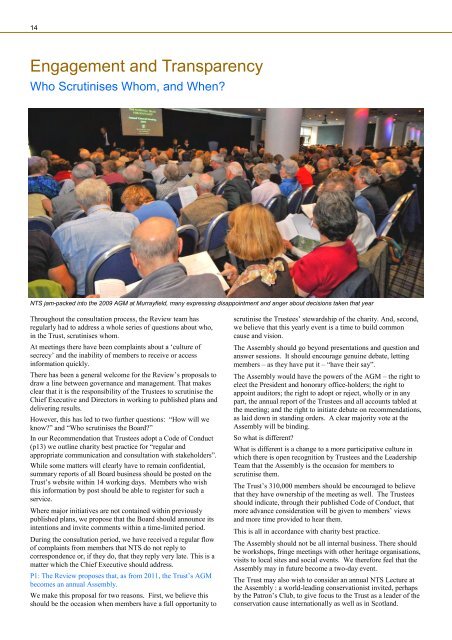NTS Report 4 Aug 2010 - National Trust for Scotland
NTS Report 4 Aug 2010 - National Trust for Scotland
NTS Report 4 Aug 2010 - National Trust for Scotland
Create successful ePaper yourself
Turn your PDF publications into a flip-book with our unique Google optimized e-Paper software.
14<br />
Engagement and Transparency<br />
Who Scrutinises Whom, and When?<br />
<strong>NTS</strong> jam-packed into the 2009 AGM at Murrayfield, many expressing disappointment and anger about decisions taken that year<br />
Throughout the consultation process, the Review team has<br />
regularly had to address a whole series of questions about who,<br />
in the <strong>Trust</strong>, scrutinises whom.<br />
At meetings there have been complaints about a ‘culture of<br />
secrecy’ and the inability of members to receive or access<br />
in<strong>for</strong>mation quickly.<br />
There has been a general welcome <strong>for</strong> the Review’s proposals to<br />
draw a line between governance and management. That makes<br />
clear that it is the responsibility of the <strong>Trust</strong>ees to scrutinise the<br />
Chief Executive and Directors in working to published plans and<br />
delivering results.<br />
However, this has led to two further questions: “How will we<br />
know?” and “Who scrutinises the Board?”<br />
In our Recommendation that <strong>Trust</strong>ees adopt a Code of Conduct<br />
(p13) we outline charity best practice <strong>for</strong> “regular and<br />
appropriate communication and consultation with stakeholders”.<br />
While some matters will clearly have to remain confidential,<br />
summary reports of all Board business should be posted on the<br />
<strong>Trust</strong>’s website within 14 working days. Members who wish<br />
this in<strong>for</strong>mation by post should be able to register <strong>for</strong> such a<br />
service.<br />
Where major initiatives are not contained within previously<br />
published plans, we propose that the Board should announce its<br />
intentions and invite comments within a time-limited period.<br />
During the consultation period, we have received a regular flow<br />
of complaints from members that <strong>NTS</strong> do not reply to<br />
correspondence or, if they do, that they reply very late. This is a<br />
matter which the Chief Executive should address.<br />
P1: The Review proposes that, as from 2011, the <strong>Trust</strong>’s AGM<br />
becomes an annual Assembly.<br />
We make this proposal <strong>for</strong> two reasons. First, we believe this<br />
should be the occasion when members have a full opportunity to<br />
scrutinise the <strong>Trust</strong>ees’ stewardship of the charity. And, second,<br />
we believe that this yearly event is a time to build common<br />
cause and vision.<br />
The Assembly should go beyond presentations and question and<br />
answer sessions. It should encourage genuine debate, letting<br />
members – as they have put it – “have their say”.<br />
The Assembly would have the powers of the AGM – the right to<br />
elect the President and honorary office-holders; the right to<br />
appoint auditors; the right to adopt or reject, wholly or in any<br />
part, the annual report of the <strong>Trust</strong>ees and all accounts tabled at<br />
the meeting; and the right to initiate debate on recommendations,<br />
as laid down in standing orders. A clear majority vote at the<br />
Assembly will be binding.<br />
So what is different?<br />
What is different is a change to a more participative culture in<br />
which there is open recognition by <strong>Trust</strong>ees and the Leadership<br />
Team that the Assembly is the occasion <strong>for</strong> members to<br />
scrutinise them.<br />
The <strong>Trust</strong>’s 310,000 members should be encouraged to believe<br />
that they have ownership of the meeting as well. The <strong>Trust</strong>ees<br />
should indicate, through their published Code of Conduct, that<br />
more advance consideration will be given to members’ views<br />
and more time provided to hear them.<br />
This is all in accordance with charity best practice.<br />
The Assembly should not be all internal business. There should<br />
be workshops, fringe meetings with other heritage organisations,<br />
visits to local sites and social events. We there<strong>for</strong>e feel that the<br />
Assembly may in future become a two-day event.<br />
The <strong>Trust</strong> may also wish to consider an annual <strong>NTS</strong> Lecture at<br />
the Assembly : a world-leading conservationist invited, perhaps<br />
by the Patron’s Club, to give focus to the <strong>Trust</strong> as a leader of the<br />
conservation cause internationally as well as in <strong>Scotland</strong>.













![Elgin Cathedral Wedding Brochure [pdf, 544kb] - Historic Scotland](https://img.yumpu.com/22301571/1/190x151/elgin-cathedral-wedding-brochure-pdf-544kb-historic-scotland.jpg?quality=85)



